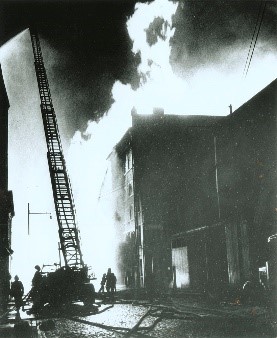
On the 28th March 1960, a fire tore across the Cheapside whiskey bond in Glasgow, causing the walls of the building to explode outwards onto the police and firefighters below. As everyone fled, a young policeman, William Gribben, spotted a firefighter buried up to his chest in the rubble and calling for help. In that moment Gribben’s first instinct must have been to turn and run – that would certainly have been the safer course of action – but instead he chose to stop and free the injured firefighter from the rubble, dragging him to safety just moments before flames engulfed the area. Ultimately, 19 firefighters lost their lives at Cheapside Street that night, but alongside that enormous loss, we can also remember the actions of William Gribben. He could have run away and not got involved, but he chose to stop and help. He chose to be an active bystander, and in doing so he saved the life of Firefighter Charles Biggerstaff, my grandfather. Despite more than 60 years passing since that night, active bystanders continue to play a vital role in our society, and in recent years, have proven to play a particularly valuable part in tackling violence and abuse.
What is a bystander?

A bystander is someone who sees a situation but isn’t actually involved in it. They’re simply a witness, someone who happens to be there. The very nature of being a bystander means that you don’t have to get involved at all. You can choose to walk away from a problematic situation with no repercussions for you. Or you could take the second option – decide that you’re going to get involved and be an active bystander. Active bystanders are a particularly valuable resource in the fight against violence and abuse. By noticing what’s happening around them and speaking out when they see problematic behaviour, active bystanders can send a clear message that violence and abuse will not be tolerated or overlooked. At Stanford University in 2015, two cyclists famously noticed a male acting suspiciously in an alley and went to investigate. Their actions interrupted Brock Turner’s attempt to rape his victim, and ultimately led to him being caught and prosecuted. These two cyclists could just have carried on with their bike ride that night. They didn’t have to stop – after all, they were just bystanders and the problematic behaviour wasn’t affecting them. But like William Gribben, they chose to stop and get involved. We continue to hear stories in the media of active bystanders who have spotted a potential problem and intervened, from the waitress in Orlando who recognised that a child may be in danger and slipped him a note asking if he needed help, to the woman walking home in London who spotted a situation that just ‘didn’t look right’ and by intervening, she prevented a child from being abducted or the bartender who recognised that a customer was being harassed and chose to do something.
What does ‘getting involved’ actually involve?
There’s a common misconception that being an active bystander means running headfirst into problematic situations and taking direct action. This can put lots of people off, especially if they don’t feel comfortable with confrontation. However, there are lots of ways to be an active bystander without ever having to directly confront someone. Yes, an active bystander will take action when they encounter problematic behavior, but that action can take lots of different forms, depending on the situation or what they feel comfortable doing. It might mean stepping outside and calling the police, creating a distraction, texting someone to see if they’re okay, or not laughing when someone tells a misogynistic joke. It can also mean noticing when a friend has bruises on their arm, offering to go to the police with them to make a report, or staying with them while they call a domestic violence helpline. Being an active bystander can be all of these things and much more. It’s about noticing when there’s potentially a problem and choosing to do SOMETHING.
The UW Bystander Intervention Programme
The University of Worcester’s Bystander Intervention programme has been running since 2016. The programme is aimed at training UW students to recognise problematic situations related to violence and abuse, and to feel confident and able to intervene. The programme takes eight hours and covers bystander theory, gender, domestic violence, sexual violence, as consent as well as developing strategies to intervene in a safe and effective way. Victim blaming myths are discussed and dispelled, and students are trained in how to best respond to someone making a disclosure. Students are taught how to spot potentially problematic behaviours, and do something to help, from supporting victims to make a report to having a conversation with a friend whose behaviour they are uncomfortable with. By offering this programme to all UW students, we aim to develop a safe a positive campus community where there is a clear message that violence and abuse will not be tolerated.
A two-year evaluation was carried out to determine the effectiveness of the UW Bystander Intervention Programme (Harrop & Taylor-Dunn, 2021). 123 students completed pre- and post-training questionnaires to measure their attitudes towards violence and abuse, and their confidence and willingness to intervene in problematic situations before and after the training. Results showed that after completing the programme, participants had a significant reduction in both hostile and benevolent sexism. There was also a significant reduction in the agreement with rape myths across four key areas (‘she asked for it’, he didn’t mean to’, ‘it wasn’t really rape’ and ‘she lied’). Participants reported that they were significantly more likely to intervene in problematic situations post-programme and had significantly reduced agreement with problematic statements. Participants also experienced a significant reduction in pluralistic ignorance post-programme, meaning that they were less likely to think that their peers condoned violence and abuse. This is an important finding as people are often more likely to intervene if they believe that the people around them will agree that there’s a problem and support their intervention.
It is extremely encouraging to see the positive impact that the UW Bystander Intervention programme has already. The programme will continue to run in the 2021-22 academic year, and there are lots of exciting developments in progress, including creating a shortened version of the programme for high school pupils and work on the role of bystander intervention in gaming. A comparison of the effectiveness of online vs face-to-face delivery of the programme will also be released later in 2021.
If you would like to hear more about the UW Bystander Programme, please feel free to contact Gill g.harrop@worc.ac.uk. You can also watch a webinar recorded earlier this year where Gill discusses the programme in more detail and her evaluation:

Dr Gillian Harrop
Gill is a senior lecturer in forensic psychology. She came to the University of Worcester from the University of Lincoln, and previously taught on both the MSc in Forensic Psychology at Liverpool University, and the BSc in Psychology at the University of East London. Prior to this, she worked for Lincolnshire Police as an Intelligence Analyst in the Force Intelligence Bureau and Major Crime Unit.
Excellent article. Superb programme at the U of W, where it has clearly been demonstrated to make a positive difference.